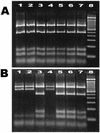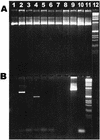Development of a PCR-restriction fragment length polymorphism assay using the nucleotide sequence of the Helicobacter hepaticus urease structural genes ureAB
- PMID: 9705372
- PMCID: PMC105142
- DOI: 10.1128/JCM.36.9.2447-2453.1998
Development of a PCR-restriction fragment length polymorphism assay using the nucleotide sequence of the Helicobacter hepaticus urease structural genes ureAB
Abstract
Infection with Helicobacter hepaticus causes chronic active hepatitis in certain strains of mice and is associated with hepatocellular carcinoma in A/JCr mice. Like the gastric helicobacters, H. pylori and H. mustelae, H. hepaticus possesses a high level of urease activity. However, the H. hepaticus urease structural gene sequences have not been previously determined, and the role of the urease enzyme in colonization and in pathogenesis is not known. PCR was used to amplify a portion of the urease structural genes from H. hepaticus genomic DNA. Amplified DNA fragments were cloned, and the nucleotide sequence was determined. The deduced amino acid sequence of the partial H. hepaticus ureA gene product was found to exhibit 60% identity and 75% similarity to the predicted H. pylori UreA. The deduced amino acid sequence of a partial H. hepaticus ureB gene product exhibited 75% identity and 87% similarity to the predicted H. pylori UreB. Diversity among H. hepaticus isolates was evaluated by means of a restriction fragment length polymorphism (RFLP) assay. The 1.6-kb fragments within the ureAB open reading frames, amplified from 11 independent isolates, were digested with the restriction endonuclease HhaI. Three distinct RFLP patterns were observed. Identical RFLP profiles were noted in sequential isolates of one strain of H. hepaticus during an 18 month in vivo colonization study, suggesting that the urease genes of H. hepaticus are stable. The urease genes among H. hepaticus strains were also well conserved, showing 98.8 to 99% nucleotide sequence identity among three isolates analyzed. These findings indicate that H. hepaticus has urease structural genes which are homologous to those of the gastric Helicobacter species and that these gene sequences can be used in a PCR and RFLP assay for diagnosis of this important murine pathogen.
Figures






References
-
- Akashi H, Hayashi T, Koizuka H, Shimoyama T, Tamura T. Strain differentiation and phylogenic relationships, in terms of base sequence of the ure B gene, of Helicobacter pylori. J Gastroenterol. 1996;31:16–23. - PubMed
-
- Bayerdorffer E, Neubauer A, Rudolph B, Thiede C, Lehn N, Eidt S, Stolte M. Regression of primary gastric lymphoma of mucosa-associated lymphoid tissue type after cure of Helicobacter pylori infection. Lancet. 1995;345:1591–1594. - PubMed
-
- Bickley J, Owen R J, Fraser A G, Pounder R E. Evaluation of the polymerase chain reaction for detecting the urease C gene of Helicobacter pylori in gastric biopsy samples and dental plaque. J Med Microbiol. 1993;39:338–344. - PubMed
Publication types
MeSH terms
Substances
Associated data
- Actions
- Actions
- Actions
Grants and funding
LinkOut - more resources
Full Text Sources
Other Literature Sources
Medical
Molecular Biology Databases

